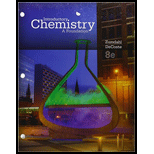
Concept explainers
(a)
Interpretation:
Interpret and complete the following reaction.
Concept Introduction:
The decaying of an atom takes place by three type of decay such as alpha decay, beta decay, gama decay.
In alpha decay, an alpha particle with mass 4m and electron 2e removed from nuclide while in beta decay two type of decay are possible beta (+) and beta (-). In gamma decay, nuclide will remain same to the original one.
(b)
Interpretation:
Interpret and complete the following reaction.
Concept Introduction:
The decaying of an atom takes place by three type of decay such as alpha decay, beta decay, gama decay.
In alpha decay, an alpha particle with mass 4m and electron 2e removed from nuclide while in beta decay two type of decay are possible beta (+) and beta (-). In gamma decay, nuclide will remain same to the original one.
(c)
Interpretation:
Interpret and complete the following reaction.
Concept Introduction:
The decaying of an atom takes place by three type of decay such as alpha decay, beta decay, gama decay.
In alpha decay, an alpha particle with mass 4m and electron 2e removed from nuclide while in beta decay two type of decay are possible beta (+) and beta (-). In gamma decay, nuclide will remain same to the original one.
Want to see the full answer?
Check out a sample textbook solution
Chapter 19 Solutions
Bundle: Introductory Chemistry: A Foundation, 8th + OWLv2 6-Months Printed Access Card
 Introductory Chemistry: A FoundationChemistryISBN:9781337399425Author:Steven S. Zumdahl, Donald J. DeCostePublisher:Cengage Learning
Introductory Chemistry: A FoundationChemistryISBN:9781337399425Author:Steven S. Zumdahl, Donald J. DeCostePublisher:Cengage Learning Introductory Chemistry: An Active Learning Approa...ChemistryISBN:9781305079250Author:Mark S. Cracolice, Ed PetersPublisher:Cengage Learning
Introductory Chemistry: An Active Learning Approa...ChemistryISBN:9781305079250Author:Mark S. Cracolice, Ed PetersPublisher:Cengage Learning General Chemistry - Standalone book (MindTap Cour...ChemistryISBN:9781305580343Author:Steven D. Gammon, Ebbing, Darrell Ebbing, Steven D., Darrell; Gammon, Darrell Ebbing; Steven D. Gammon, Darrell D.; Gammon, Ebbing; Steven D. Gammon; DarrellPublisher:Cengage Learning
General Chemistry - Standalone book (MindTap Cour...ChemistryISBN:9781305580343Author:Steven D. Gammon, Ebbing, Darrell Ebbing, Steven D., Darrell; Gammon, Darrell Ebbing; Steven D. Gammon, Darrell D.; Gammon, Ebbing; Steven D. Gammon; DarrellPublisher:Cengage Learning ChemistryChemistryISBN:9781305957404Author:Steven S. Zumdahl, Susan A. Zumdahl, Donald J. DeCostePublisher:Cengage Learning
ChemistryChemistryISBN:9781305957404Author:Steven S. Zumdahl, Susan A. Zumdahl, Donald J. DeCostePublisher:Cengage Learning
 Chemistry: An Atoms First ApproachChemistryISBN:9781305079243Author:Steven S. Zumdahl, Susan A. ZumdahlPublisher:Cengage Learning
Chemistry: An Atoms First ApproachChemistryISBN:9781305079243Author:Steven S. Zumdahl, Susan A. ZumdahlPublisher:Cengage Learning





